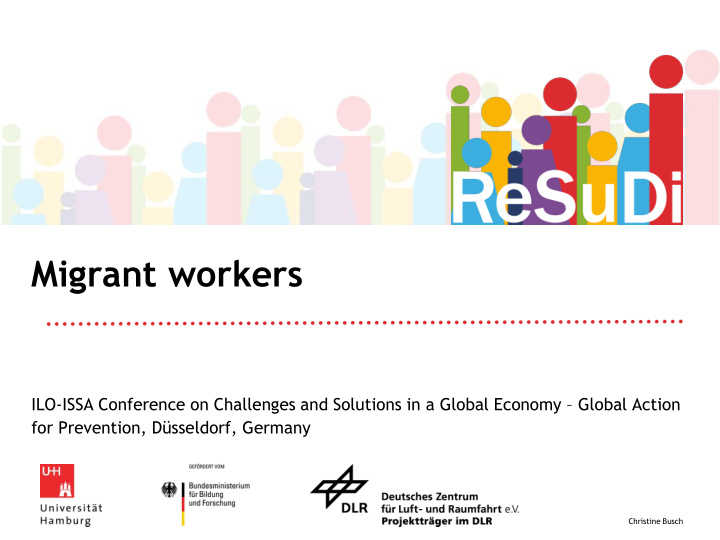



– – – Migrant workers ILO-ISSA Conference on Challenges and Solutions in a Global Economy – Global Action for Prevention, Düsseldorf, Germany Christine Busch
– – – Immigrants in Germany I Steady increase of immigrants in Germany in the past decades Sudden increase of refugees in 2014/15 (mainly from Syria, Kosovo, Albania, Serbia, Iraq, Afghanistan, Macedonia, Eritrea, Nigeria, Pakistan) In 2013, 20% of the German population had a migration background In 2013, Germany had a positive migration balance of 437.000 persons, mainly from Poland, Romania, Hungary, Bulgaria and Italy 75% of immigrants have more than 80 different migration backgrounds; Turkish background is dominant (16%) 60% of immigrants in Germany have low to middle qualification 35% of immigrants do not acquire formal job qualification 2 Christine Busch
– – – Immigrants in Germany II 50% of the workers without any job qualification in Germany are immigrant workers There are hardly any countries with immigrants, who are as low qualified as those in Germany Immigrants have a higher risk of unemployment and of working in low-skilled jobs than Germans Immigrants experience more social stressors at work than Germans and similar levels of task-related stressors Job control serves as a resource only among Germans, support is more important for immigrant workers (Busch, 2015; Grünheid u. Fiedler 2013; Hoppe, 2011; StaBa, 2013) 3 Christine Busch
– – – Low-skilled jobs Workers in low-skilled jobs are exposed to disadvantageous working conditions: low income, high job insecurity, low appreciation, low control, low social support, high physical demands, often repetitive work (Borrell et al., 2004; Niedhammer et al. 2008; Schreuder et al. 2008; Rydstedt et al. 2007) Multicultural workgroups show communication difficulties, social isolation, divergent values, high absenteeism and fluctuation (Busch & Clasen, 2013) 4 Christine Busch
– – – Social gradient of health Individuals with low socio-economic status (SES) are facing higher morbidity and mortality risks than people with higher SES (Borrell et al., 2004; Klein, 2008; Lampert et al. 2010) Low SES individuals are especially prone to suffer from cardiovascular disease (CVD) Immigrants show more musculoskeletal disorders, pain, psychosomatic and psychological distress than Germans Immigrant workers have more accidents at work, more sick days and higher early retirement rates because of occupational diseases than German workers (Brzoska et al., 2010; Steptoe et al. 2003; Lampert & Kroll, 2010; Lampert et al., 2010) 5 Christine Busch
– – – ReSuDi … is an organizational health intervention program consider the multicultural work environment of workers in low- skilled jobs consider the low participation rates of immigrants in intervention programs offers: the implementation of peer-mentoring and training of peer-mentors training of line managers workshop for senior management is evaluated (health and cost effectiveness) is manualized and published in German (Busch, Cao, Clasen & Deci, 2014) 6 Christine Busch
– – – ReSuDi Peer mentors … are voluntary workers in low-skilled jobs are elected by their co-workers and line managers represent the cultural diversity of the workgroup are positive role models for stress management strengthen social support and initiate improvements at work get official working-time slots to fulfil their active and passive role work in a network of at least four peer mentors in each worksite have a maximum of 20 protégés 7 Christine Busch
– – – 8 Christine Busch
– – – Evaluation ReSuDi was implemented and evaluated in three companies of different industries and German regions Quasi-experimental (waiting) control group design ( pre-, post- and follow-up measurements with a three-months time-lag) N = 425; 50% immigrants; 50% women Trained multiplier: 23 peer-mentors (9 (39%) immigrants; 13 (57%) women) 18 line managers (3 (17%) immigrants; 6 (33%) women) 9 Christine Busch
– – – Health Effectiveness Casual blood pressure Psychosomatic complaints (Busch, Clasen et al., 2015; Busch, Koch, et al., under review) 10 Christine Busch
– – – Cost Effectiveness Direct costing method tool CACHe.Pro to calculate direct costs and benefits of worksite health promotion interventions (available at www.resudi.uni-hamburg.de) Break-even point is 0.6, that means the costs are fully compensated with a reduction of absenteeism of 0.6 days for each worker and year ReSuDi-evaluation: 0.8 days for each participating worker (Gloede, 2013; Busch et al., 2014) 11 Christine Busch
– – – Conclusions Immigrants in Germany have a high risk of low SES and of working in low-skilled jobs Immigrants have greater difficulty participating in health intervention programs ReSuDi is an effective and efficient health promoting intervention for immigrants and indigenous workers in low-skilled jobs who work in Germany in a multicultural work environment Thank you very much for your attention! 12 Christine Busch
Recommend
More recommend